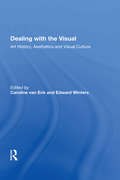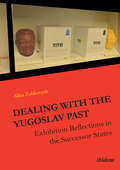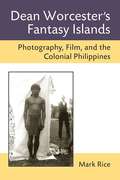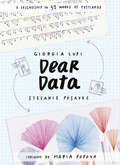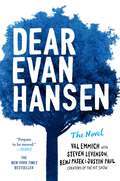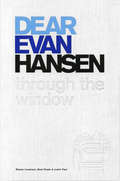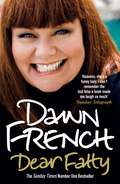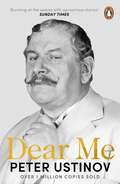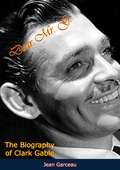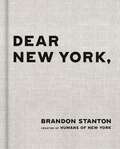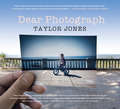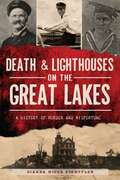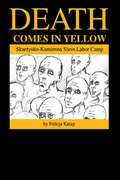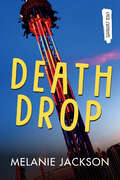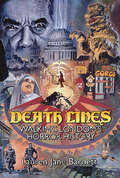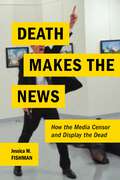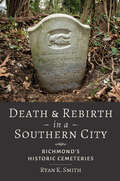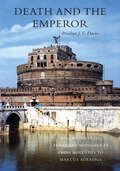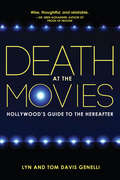- Table View
- List View
Dealing with the Visual: Art History, Aesthetics and Visual Culture (Histories Of Vision Ser.)
by Edward Winters Caroline van EckOne of the issues underlying current debates between practitioners of art history, visual culture and aesthetics is whether the visual is a unique, irreducible category, or whether it can be assimilated with the textual or verbal without any significant loss. Can paintings, buildings or installations be 'read' in the way texts are read or deciphered, or do works of visual art ask for their own kind of appreciation? This is not only a question of choosing the right method in dealing with visual works of art, but also an issue that touches on the roots of the disciplines involved: can a case be made for the visual as an irreducible category of art, and if so, how is it best studied and appreciated? In this anthology, this question is approached from the angles of three disciplines: aesthetics, visual culture and art history. Unlike many existing overviews of visual culture studies, it includes both painting and architecture, and investigates historical ways of defining and appreciating the visual in their own, contemporary terms. Dealing with the Visual will be of great use to advanced students because it offers an overview of current debates, and to graduate students and professionals in the field because the essays offer in-depth investigations of the methodological issues involved and various historical ways of defining visuality. The topics included range from early modern ways of viewing pictures and sixteenth-century views of Palladio's villas in their landscape settings to contemporary debate about whether there is life yet in painting.
Dealing with the Yugoslav Past: Exhibition Reflections in the Successor States
by Alina ZubkovychThis book analyzes the representation of the socialist past in the national history museums of the former Yugoslavia. Through travels to Croatia, Bosnia and Herzegovina, Montenegro, Kosovo, and Macedonia, the study elucidates the process of constructing the national narratives that maintain and legitimize a particular vision of the common past. Cross-national comparison allows for analysis of the democratic development of each state in relation to the politics of memory in the region and the role of political actors in its construction.
Dean Worcester's Fantasy Islands: Photography, Film, And The Colonial Philippines
by Mark RiceDean Worcester’s Fantasy Islands brings to life one of the most significant (but under examined) figures in the history of U. S. colonialism in the Philippines. Upon the outbreak of the Spanish-American War, Worcester, a scientist who had traveled twice to the Philippines on zoological expeditions, established himself as one of America’s leading experts on the Philippines. Over a fourteen-year career as a member of the U. S. colonial regime, Worcester devoted much of his time and energy to traveling among and photographing non-Christian minority groups in the Philippines. He amassed an archive of several thousand photographs taken by him or by government photographers. Worcester deployed those photographs in books, magazine articles, and lectures to promote his belief that the United States should maintain control of the Philippines for decades to come. While many historians have examined American colonial photography in the Philippines, this book is the first lengthy treatment of Worcester’s role in shaping American perceptions of the Philippines in the early twentieth century.
Deanna Durbin, Judy Garland, and the Golden Age of Hollywood
by Melanie GallThe 1930s was a magical age in Hollywood, with Shirley Temple and Mickey Rooney, Bette Davis and Clark Gable lighting up the silver screen. But Deanna Durbin's fame surpassed them all. Born in Canada, Deanna was &“discovered&” by starmaker Eddie Cantor, producer Joe Pasternak and director Henry Koster, and she quickly became the world&’s most celebrated star. She saved Universal Studios from ruin, she was a favourite of Winston Churchill and Anne Frank, and she became the highest-paid woman in America. From the start, Deanna&’s life was irrevocably connected with that of another young ingénue, Judy Garland. Deanna and Judy were wildly talented, ambitious, and strong-willed young women who followed vastly different paths to stardom. While fame was thrust upon Deanna, Judy spent years struggling for success and their early friendship soon turned into a lifelong rivalry. Despite her tragic life, Judy Garland is remembered as an entertainment icon, beloved by millions. However, Deanna Durbin—who turned her back on Hollywood at the age of twenty-eight to pursue love and happiness—has been largely forgotten. But Deanna&’s legacy endures, and this first-ever biography tells of how her gorgeous voice and winning charm vaulted her to worldwide fame and how a thirteen-year-old girl transformed moviemaking and influenced a generation of fans as the first teenage superstar.
Dear Data
by Giorgia Lupi Stefanie PosavecEqual parts mail art, data visualization, and affectionate correspondence, Dear Data celebrates "the infinitesimal, incomplete, imperfect, yet exquisitely human details of life," in the words of Maria Popova (Brain Pickings), who introduces this charming and graphically powerful book. For one year, Giorgia Lupi, an Italian living in New York, and Stefanie Posavec, an American in London, mapped the particulars of their daily lives as a series of hand-drawn postcards they exchanged via mail weekly—small portraits as full of emotion as they are data, both mundane and magical. Dear Data reproduces in pinpoint detail the full year's set of cards, front and back, providing a remarkable portrait of two artists connected by their attention to the details of their lives—including complaints, distractions, phone addictions, physical contact, and desires. These details illuminate the lives of two remarkable young women and also inspire us to map our own lives, including specific suggestions on what data to draw and how. A captivating and unique book for designers, artists, correspondents, friends, and lovers everywhere.
Dear Evan Hansen: The Novel
by Val Emmich Steven Levenson Benj Pasek Justin PaulFrom the show's creators comes the groundbreaking novel inspired by the hit Broadway show Dear Evan Hansen. Dear Evan Hansen, Today's going to be an amazing day and here's why...When a letter that was never meant to be seen by anyone draws high school senior Evan Hansen into a family's grief over the loss of their son, he is given the chance of a lifetime: to belong. He just has to stick to a lie he never meant to tell, that the notoriously troubled Connor Murphy was his secret best friend. <p><p> Suddenly, Evan isn't invisible anymore--even to the girl of his dreams. And Connor Murphy's parents, with their beautiful home on the other side of town, have taken him in like he was their own, desperate to know more about their enigmatic son from his closest friend. As Evan gets pulled deeper into their swirl of anger, regret, and confusion, he knows that what he's doing can't be right, but if he's helping people, how wrong can it be? No longer tangled in his once-incapacitating anxiety, this new Evan has a purpose. And a website. He's confident. He's a viral phenomenon. Every day is amazing. Until everything is in danger of unraveling and he comes face to face with his greatest obstacle: himself. <p> A simple lie leads to complicated truths in this big-hearted coming-of-age story of grief, authenticity and the struggle to belong in an age of instant connectivity and profound isolation.
Dear Evan Hansen: Through the Window
by Steven LevensonWinner of 6 Tony Awards!The official behind-the-scenes book of the new hit musical.A letter that was never meant to be seen, a lie that was never meant to be told, a life he never dreamed he could have. Evan Hansen is about to get the one thing he's always wanted: a chance to finally fit in. Both deeply personal and profoundly contemporary, DEAR EVAN HANSEN is a new American musical about life and the way we live it.The book-produced by Melcher Media, the team behind Hamilton, Wicked, Rent, and many more-tells the story of the musical from its conception nearly a decade ago to the Broadway stage. From developing the idea to writing the show, composing, casting, and rehearsals, DEAR EVAN HANSEN appeals to fans far and wide offering them the opportunity to continuously revisit the show, and for those who haven't seen the musical, reading the book will make them feel like they have.Filled with interviews with the cast and crew, original behind-the-scenes photography, a deeper look into Evan's fictional world and the visual world of the show, unreleased lyrics, and of course the libretto, as well as reflections on the creators own formative memories from their adolescence as it relates to the show's themes, and important examinations of how we present ourselves online and mental health, DEAR EVAN HANSEN is a beautifully produced, thoughtful, and uplifting book.
Dear Fatty: The hilarious and heartwarming memoir from one of Britain's best-loved comedians
by Dawn FrenchA SUNDAY TIMES NUMBER ONE BESTSELLER___________________________The hilarious and heartwarming memoir from one of Britain's best-loved comedians and Women's Prize longlisted author, Dawn French.Dawn French is one of the greatest comedians of our time with a career that has spanned nearly four decades. Loved for her irreverent humour, Dawn has achieved massive mainstream success while continuing to push boundaries and challenge stereotypes. Here, she describes the journey that would eventually establish her as a perhaps unlikely, but nevertheless genuine, national treasure. As part of the much loved duo French and Saunders, Dawn helped create a repertoire of brilliantly observed characters, impersonating everything from Madonna and Harry Potter to The Exorcist. Dawn's iconic role in the Vicar of Dibley showcased not only her talent but also her ability to take a controversial and topical issue and make it mainstream - and very funny.From her early years as an RAF child and her flat-sharing antics with Jennifer Saunders, to her outspoken views on sizism and her marriage to Lenny Henry, Dear Fatty chronicles the extraordinary and hilarious rise of a complex, dynamic and unstoppable woman.
Dear God (From the Major Motion Picture: Letters To God)
by André K Dugger[Back Cover]: " 'Dear God' With those simple words, a young boy with cancer begins a letter-writing conversation that explores everything from the meaning of his illness to how he help his loved ones cope with it. Through his letters, he gives us an insightful look at faith, grace, and hope in the face of unspeakable sorrow, Based on the major motion picture Letters to God, this book includes dozens of stills from the movie and letters written by the film's central character, Tyler. Fatherless at age three and diagnosed with cancer at seven, Tyler opens his heart to God in a series of written prayers. Here, each prayer is accompanied by a Scripture reference and insight that will help you apply Tyler's wisdom to daily life. This inspiring gift will guide you, no matter what your age, into a deeper faith walk, one built on the simple truth that Tyler dearly understood--the storms of life rain on God's children to draw them closer to himself."
Dear James
by R. O. BlechmanRENOWNED ARTIST R. O. BLECHMAN'S illustrations are instantly recognizable. For more than fifty years, his work has appeared on the covers of The New Yorker, run alongside op-eds in The New York Times, graced the pages of Harper's Bazaar, and, more recently, been featured on The Huffington Post, providing unspoken commentary on the world at large. In Dear James, Blechman has compiled all the wisdom he has accumulated over the course of his esteemed career into a series of poignant yet instructive letters written to an imagined young illustrator, "James." The result is a wise and mesmerizing meditation on creativity. Flush with wit and candor, Blechman's correspondence delves into his own trash can of false starts and failed beginnings, in addition to his artistic triumphs, to offer James both encouragement and criticism. He urges him to reach his potential as an artist, advising him on practical aspects -- proper technique, choice of work environments, dealing with editors -- and along the way provides invaluable insights on art, and life, that lay bare the challenges James will face as he aims to be successful in this demanding field. In the tradition of Rilke's Letters to a Young Poet, Dear James is an indispensable tool for any up-and-coming creative person looking for advice and inspiration, as well as a memorable read for those daring enough to chase their dreams.
Dear James: Letters to a Young Illustrator
by R. O. BlechmanRENOWNED ARTIST R O. BLECHMAN'S illustrations are instantly recognizable. For more than fifty years, his work has appeared on the covers of The New Yorker, run alongside op-eds in The New York Times, graced the pages of Harper's Bazaar, and, more recently, been featured on The Huffington Post, providing unspoken commentary on the world at large. In Dear James, Blechman has compiled all the wisdom he has accumulated over the course of his esteemed career into a series of poignant yet instructive letters written to an imagined young illustrator, "James." The result is a wise and mesmerizing meditation on creativity. Flush with wit and candor, Blechman's correspondence delves into his own trash can of false starts and failed beginnings, in addition to his artistic triumphs, to offer James both encouragement and criticism. He urges him to reach his potential as an artist, advising him on practical aspects -- proper technique, choice of work environments, dealing with editors -- and along the way provides invaluable insights on art, and life, that lay bare the challenges James will face as he aims to be successful in this demanding field. In the tradition of Rilke's Letters to a Young Poet,Dear Jamesis an indispensable tool for any up-and-coming creative person looking for advice and inspiration, as well as a memorable read for those daring enough to chase their dreams.
Dear Joan and Jericha - Why He Turns Away: Do’s and Don’ts, from Dating to Death
by Joan Damry Jericha DomainFrom the world-renowned agony aunts of award-winning podcast 'Dear Joan and Jericha' comes an unputdownable bible of sex and relationship advice on how to find, satisfy and maintain a husband, from dating right up until you or hubby pass away.We dedicate this tome to Mahmoud: surgeon, prophet, model and friend. Capable of performing up to 30 hysterectomies a day (often blindfolded), it was Mahmoud that begged us to put pen to papyrus and share our wisdom with all the lost ladies suffering in the world today. As much revered celebrities, living glamorous and wealthy lifestyles, we do of course come under fire. There has recently been vicious slander circulating, regarding a small handful of folk who have written to us with a problem, and having listened to our response, gone on to take their own lives. As if the two were somehow connected. These naysayers are generally bitter and jealous spinsters, taking perverse and sadistic pleasure in being vindictive and nasty, while no doubt masturbating at the same time. To these lonely ladies we would say, 'Go look in your own heart, knock ye there and ask yourself some difficult questions. Because you will find the real guilt writhing within ye, like maggots mating in yesterday's apple'. What we offer here is a lifeline, a service, much like the NHS, or perhaps more accurately, the AA. Joan and Jericha: AA for the heart. Affording you the opportunity to have a breakdown, call for a pick-up truck, stop off for a Full English whilst a hairy guy in a grubby onesie fumbles under your bonnet and tweaks at your wiring, before sending you on your way, lubricated, primed, pumped and pretty. With kind regards, Joan Damry and Jericha Domain OBE MBE (etc)
Dear Me
by Peter Ustinov‘Very amusing’Daily MirrorBeloved wit and raconteur, star of stage and screen, multitalented writer, director and humanitarian – few stars of the twentieth century were as highly regarded as Sir Peter Ustinov.From his birth in April 1921, this highly acclaimed autobiography spans Ustinov’s extraordinary career as the star of Spartacus, Quo Vadis, Death on the Nile and many other classics. Eccentric relatives, school masters and manic Hollywood moguls are all brought unforgettably to life alongside encounters with the great and the good, from Sir Laurence Olivier to J. B. Priestley.This warm and revealing book gives an enthralling portrait of a man whose unique gift of laughter made him one of the most popular and respected entertainers in the world.
Dear Mr. G.: The Biography of Clark Gable
by Jean Garceau Inez CockeClark Gable (1901-1960) was an American film actor who is often referred to as “The King of Hollywood”. He began his career as an extra in Hollywood silent films between 1924-1926, and progressed to supporting roles with a few films for Metro-Goldwyn-Mayer in 1930. He landed his first leading role in 1931, and was a leading man in more than 60 motion pictures over the following three decades. He became best known for his performance in Gone with the Wind (1939), for which he gained a Best Actor Oscar nomination.Dear Mr. G., which was first published in 1961, is an engaging account by Clark Gable and Carole Lombard’s personal secretary and business manager, Jean Garceau.Here is the story of a kind, generous man—a man with a sense of humor and who, despite the fame and adulation, still had the humility to say, when it was suggested that he direct films, “Direct? I haven’t learned how to act yet!”This is the true story, in words and pictures, of Clark Gable’s life, chronicled by the one woman who knew him longest—Jean Garceau.
Dear New York
by Brandon StantonTHE INSTANT NEW YORK TIMES BESTSELLERThe inspiration for the groundbreaking Grand Central Station installation, Dear New York is a love letter to the streets, stories, and souls that define the heart of the city and its people―from the #1 bestselling author of Humans of New York and one of the great storytellers of our time.Creator of the global sensation “Humans of New York” and author of four #1 New York Times bestsellers, Brandon Stanton has shown us a unique side of our communities, our neighbors, and ourselves. Now, he takes us further and deeper than he’s ever gone before.Beginning with a deeply moving prologue that reads like a train ride through the city, the book opens up into a sweeping view of the city with hundreds of portraits and stories from every corner of the city, a new discovery on every page.Embracing all five boroughs, Dear New York is a book filled with contradictions, yet brimming with life. It is an unprecedented portrait of the world’s greatest city, and a personal tribute to the people who provide its soul.
Dear Photograph
by Taylor JonesWe all have moments we wish we could relive. We'd give anything to skid down the toboggan hills of our youth, to breathe in the smell of our children as babies, or to spend just one more minute with someone we've lost. Dear Photograph provides a way to link these memories from the past to the present, overlapping them to see how the daydreams of our memories collide with our current realities. The idea is simple: hold up a photograph from the past in front of the place where it was originally taken, take a second photograph, and add a sentence of dedication about what the photograph means to you. The results, however, are astounding, which is why millions have flocked to dearphotograph.com and thousands have submitted their own Dear Photographs. This stunning visual compilation includes more than 140 never-before-seen Dear Photographs, as well as a space for you to attach your own cherished photo. By turns nostalgic, charming, and poignant, Dear Photograph evokes childhood memories, laments difficult losses, and, above all, celebrates the universal nature of love.
Death & Lighthouses on the Great Lakes: A History of Murder and Misfortune (Murder & Mayhem)
by Dianna Higgs StampflerThe author of Michigan's Haunted Lighthouses shares tales of disaster and misfortune on the Great Lakes.Losing one's life while tending to a Great Lakes lighthouse sadly wasn't such an unusual occurrence. Death by murder, suicide or other tragic causes--while rare--were not unheard of. Two keepers on Lake Superior's Grand Island disappeared one early summer day in 1908, their decomposed remains found weeks later. A newly hired and some say depressed keeper on Pilot Island in Wisconsin's Door County slit his own throat after a consultation with a local butcher about the location of the jugular vein. A smallpox outbreak in the late 1890s led to the tragic death of a lighthouse hired hand on South Bass Island in Lake Erie.Join author Dianna Stampfler as she uncovers the facts (and debunks some fiction) behind some of the Great Lakes' darkest lighthouse tales.
Death Comes in Yellow
by Felicja KarayDeath Comes in Yellow" presents the history of one slave labor camp in order to shed light on all aspects of the slave labor camps established in Poland under German occupation. Hasag-Skarzysko was one of hundreds of camps scattered throughout occupied Poland. They were distinguished by size, the nationality of the prisoners, their location, the date of their establishment, and the authority in charge. The large number of labor camps reflected the German policy of exploiting the work forces of the occupied countries. These camps were part of a Europe-wide system of forced labor.The first part of this volume reviews the external history of the camp. The second section, which studies the internal workings of the camp, is quite different in approach and includes an analysis of prisoner society and a moving description of the individual prisoner's struggle to survive.
Death Drop (Orca Currents)
by Melanie JacksonOn his way to baseball practice, Zeke lines up for Vancouver's newest thrill ride: Death Drop, an elevator that falls faster than gravity. The theme of the ride is based on the story of Persephone, who tumbled into the underworld. Zeke tumbles into a frightening situation himself after he discovers a little girl who is lost. He takes her to the Death Drop manager's office. But later, when he tries to find out what happened with her, the ride's staff say they never saw her! To find the missing girl, Zeke must navigate a devilish plot that includes Dante Gabriel Rossetti's famous painting Proserpine, a fiery drop into flames, and an angry coach. This short novel is a high-interest, low-reading level book for middle-grade readers who are building reading skills, want a quick read or say they don’t like to read! The epub edition of this title is fully accessible.
Death Lines: Walking London's Horror History
by Lauren BarnettThe first walking guide to London&’s role in the evolution of horror cinema, inspired by the city&’s dark histories and labyrinthine architectures.Death Lines is the first walking guide to London&’s role in the evolution of horror cinema, inspired by the city&’s dark histories, labyrinthine architectures, atmospheric streetscapes, and uncanny denizens. Its eight walks lead you on a series of richly researched yet undeniably chilling tours through Chelsea, Notting Hill, Westminster, Bloomsbury, Covent Garden, and the East End, along the haunted banks of the river Thames, and down into the depths of the London Underground railway. Each tour weaves together London&’s stories and takes the reader to magnificent, eerie, and sometimes disconcertingly ordinary corners of the city, unearthing the literature, legends, and history behind classics like Peeping Tom and An American Werewolf in London, and lesser-known works such as mind-control melodrama The Sorcerers; Gorgo, Britain&’s answer to Godzilla; tube terror Death Line; and Bela Lugosi's mesmeric vehicle The Dark Eyes of London. Tinged with humor, social critique, and more than a few scares, Death Lines delights in revealing the hidden and often surprising relationship between the city and the dark cinematic visions it has evoked. Whether read on the streets or from the comfort of the grave, Death Lines is a treat for all cinephiles, horror fans, and lovers of London lore.
Death Makes the News: How the Media Censor and Display the Dead
by Jessica M. FishmanWinner of the 2018 Media Ecology Association's Erving Goffman Award for Outstanding Scholarship in the Ecology of Social InteractionWinner of the Eastern Communication Association's Everett Lee Hunt AwardA behind-the-scenes account of how death is presented in the mediaDeath is considered one of the most newsworthy events, but words do not tell the whole story. Pictures are also at the epicenter of journalism, and when photographers and editors illustrate fatalities, it often raises questions about how they distinguish between a “fit” and “unfit” image of death.Death Makes the News is the story of this controversial news practice: picturing the dead. Jessica Fishman uncovers the surprising editorial and political forces that structure how the news and media cover death. The patterns are striking, overturning long-held assumptions about which deaths are newsworthy and raising fundamental questions about the role that news images play in our society.In a look behind the curtain of newsrooms, Fishman observes editors and photojournalists from different types of organizations as they deliberate over which images of death make the cut, and why. She also investigates over 30 years of photojournalism in the tabloid and patrician press to establish when the dead are shown and whose dead body is most newsworthy, illustrating her findings with high-profile news events, including recent plane crashes, earthquakes, hurricanes, homicides, political unrest, and war-time attacks. Death Makes the News reveals that much of what we think we know about the news is wrong: while the patrician press claims that they do not show dead bodies, they are actually more likely than the tabloid press to show them—even though the tabloids actually claim to have no qualms showing these bodies. Dead foreigners are more likely to be shown than American bodies. At the same time, there are other unexpected but vivid patterns that offer insight into persistent editorial forces that routinely structure news coverage of death. An original view on the depiction of dead bodies in the media, Death Makes the News opens up new ways of thinking about how death is portrayed.
Death Ride of the Panzers: German Armor and the Retreat in the West, 1944-45
by Dennis OliverDeath Ride of the Panzers is a unique guide to the Nazi tanks, vehicles, and crews of World War II. It features never-before-seen photographs from the US National Archives and the author's personal collection, annotated artist renderings, and detailed explanations and historical context for each collection of images. Readers will also be able to trace the combat histories of these subjects through orders of battle, maps and organizational diagrams, vehicle allocation charts, and unit biographies. The forensic approach for which Dennis Oliver is known creates a broad, comprehensive record of German soldiers and hardware from early 1944 to the end of the conflict in 1945. Death Ride of the Panzers provides the context and chronology necessary for the general reader and the primary sources and hardware specifics that appeal to the expert, making this book perfect for the readers with historical interest, modelers, and WWII alike.
Death and Rebirth in a Southern City: Richmond's Historic Cemeteries
by Ryan K. SmithThis exploration of Richmond's burial landscape over the past 300 years reveals in illuminating detail how racism and the color line have consistently shaped death, burial, and remembrance in this storied Southern capital.Richmond, Virginia, the former capital of the Confederacy, holds one of the most dramatic landscapes of death in the nation. Its burial grounds show the sweep of Southern history on an epic scale, from the earliest English encounters with the Powhatan at the falls of the James River through slavery, the Civil War, and the long reckoning that followed. And while the region's deathways and burial practices have developed in surprising directions over these centuries, one element has remained stubbornly the same: the color line. But something different is happening now. The latest phase of this history points to a quiet revolution taking place in Virginia and beyond. Where white leaders long bolstered their heritage and authority with a disregard for the graves of the disenfranchised, today activist groups have stepped forward to reorganize and reclaim the commemorative landscape for the remains of people of color and religious minorities. In Death and Rebirth in a Southern City, Ryan K. Smith explores more than a dozen of Richmond's most historically and culturally significant cemeteries. He traces the disparities between those grounds which have been well-maintained, preserving the legacies of privileged whites, and those that have been worn away, dug up, and built over, erasing the memories of African Americans and indigenous tribes. Drawing on extensive oral histories and archival research, Smith unearths the heritage of these marginalized communities and explains what the city must do to conserve these gravesites and bring racial equity to these arenas for public memory. He also shows how the ongoing recovery efforts point to a redefinition of Confederate memory and the possibility of a rebirthed community in the symbolic center of the South.The book encompasses, among others, St. John's colonial churchyard; African burial grounds in Shockoe Bottom and on Shockoe Hill; Hebrew Cemetery; Hollywood Cemetery, with its 18,000 Confederate dead; Richmond National Cemetery; and Evergreen Cemetery, home to tens of thousands of black burials from the Jim Crow era. Smith's rich analysis of the surviving grounds documents many of these sites for the first time and is enhanced by an accompanying website, www.richmondcemeteries.org. A brilliant example of public history, Death and Rebirth in a Southern City reveals how cemeteries can frame changes in politics and society across time.
Death and the Emperor: Roman Imperial Funerary Monuments from Augustus to Marcus Aurelius
by Penelope J. E. DaviesIn this book, Penelope Davies studies the role of monuments in the Roman imperial cult.
Death at the Movies
by Tom Davis Genelli Lyn Davis GenelliIt's a Wonderful Life (1946), Resurrection (1980), Poltergeist (1982), Beetlejuice (1988), Ghost (1990), Groundhog Day (1993), The Sixth Sense (1999) -- these are only a few of the influential movies in recent decades dealing with the afterlife. But beyond entertainment, do they mean anything? The authors of this wise and well-informed guide believe so. They explore how popular motion pictures, from Outward Bound (1930) to Hereafter, play a perhaps unconscious role in guiding humanity toward its evolutionary comprehension of the meaning and purpose of death. They draw on the Tibetan Book of the Dead, Buddhism, and depth psychology to review some of the most spiritually powerful films ever made. Death is, say the authors, at once the most immediate locked door and the ultimate frontier, a staggering paradox that invites us to search for deeper understanding based upon a level of consciousness beyond thought. After reading this book, you'll never view Casablanca or The Wizard of Oz the same way again.
